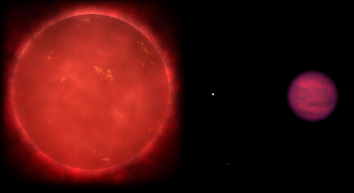Adapted by Emily Howard
Today, a team of researchers, including those at McDonald Observatory, has announced the first significant detection of phosphine in the atmosphere of a cool brown dwarf named Wolf 1130C. With the discovery, astronomers are a step closer to understanding the processes behind how this molecule – an important marker for life - forms. They are also left scratching their heads as to why they haven’t yet detected it in other, similar objects.
Their research was published in the journal Science.
Phosphine is an explosive, highly toxic gas. It forms when phosphorus – one of the six key elements necessary for life on Earth – combines with hydrogen. In the hydrogen-rich atmospheres of Jupiter and Saturn, phosphine forms naturally. However, here on Earth it is also a byproduct of anaerobic life. For example, it can come from decaying, organic swamp matter.
To identify when phosphine is the product of organic processes, astronomers need to know when it isn’t. However, this has proven more difficult than expected. Because of phosphine’s abundance in the atmospheres of Jupiter and Saturn, scientists have long predicted it would be present in the atmospheres of gas giants orbiting other stars, and in their more massive cousins, brown dwarfs.
When the James Webb Space Telescope launched in 2021, astronomers were finally able to test this theory. This is the first telescope with the sensitivity to look at these celestial objects in detail. Yet phosphine has largely eluded detection, suggesting problems with our understanding of phosphorus chemistry.
“Our program, Arcana of the Ancients, focuses on old, metal-poor brown dwarfs as a means of testing our understanding of atmospheric chemistry,” said lead author Adam Burgasser, professor of astronomy and astrophysics at the University of California San Diego. In astronomy, “metals” are essentially any elements other than hydrogen and helium. “Understanding the problem with phosphine was one of our first goals.”
“Prior to JWST, phosphine was expected to be abundant in exoplanet and brown dwarf atmospheres,” added co-author Sam Beiler, a postdoctoral scholar at Trinity College Dublin. "Every observation we've obtained with JWST has challenged the theoretical predictions. That is, until we observed Wolf 1130C.”
In the star system Wolf 1130ABC, located 54 light-years from the Sun in the constellation Cygnus, the brown dwarf Wolf 1130C follows a wide orbit around a tight double star system, composed of a cool red star (Wolf 1130A) and a massive white dwarf (Wolf 1130B).
Unlike other brown dwarfs, the team easily spotted phosphine in JWST’s data of Wolf 1130C. “Many of the JWST observations of these objects have shown no detection of phosphine at the 1 part per billion limit,” explained co-author Greg Mace, a research scientist at McDonald Observatory who discovered the brown dwarf in 2013. “Wolf 1130C surprised us because the 100 parts per billion detection is bigger than we have seen outside our solar system.”
While the researchers are delighted by their discovery, it raises an issue: why is phosphine present in the atmosphere of this brown dwarf and not others?
One possibility is the low abundance of metals in Wolf 1130C’s atmosphere, which may change its underlying chemistry. “It may be that in normal conditions phosphorus is bound up in another molecule such as phosphorus trioxide,” explained Beiler. “In the metal-depleted atmosphere of Wolf 1130C, there isn’t enough oxygen to take up the phosphorus, allowing phosphine to form from the abundant hydrogen.”
Another possibility is that phosphorus was generated locally in the Wolf 1130ABC system, specifically by its white dwarf, Wolf 1130B. "A white dwarf is the leftover husk of a star that has finished fusing its hydrogen," explained Burgasser. "They are so dense that when they accrete material on their surface they can undergo runaway nuclear reactions, which we detect as novae.”
While astronomers haven't seen evidence of such events in the Wolf 1130ABC system in recent history, novae typically have outburst cycles of thousands to tens of thousands of years. This system has been known for just over a century, and early, unseen outbursts could have left a legacy of phosphorus pollution. Earlier research studies have proposed that a significant fraction of phosphorus in the Milky Way could have been synthesized by this process.
Understanding why this one brown dwarf shows a clear signature of phosphine may lead to new insights into the synthesis of phosphorus in the Milky Way and its chemistry in planetary atmospheres. “In the search for life on other planets, we need to understand how phosphine is made in any low-temperature atmosphere we discover,” said Mace. “This detection in Wolf 1130C stands out and motivates us to observe similar objects and revisit our models to narrow down our hunt for life on other planets.”
This study was funded in part by NASA/STScI (NAS 5-03127 and AR-2232) and the Heising-Simons Foundation.






